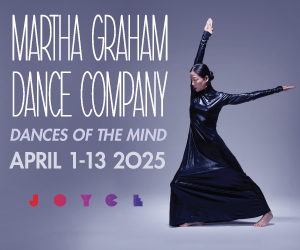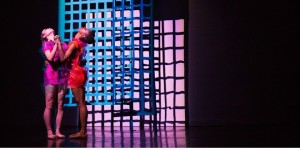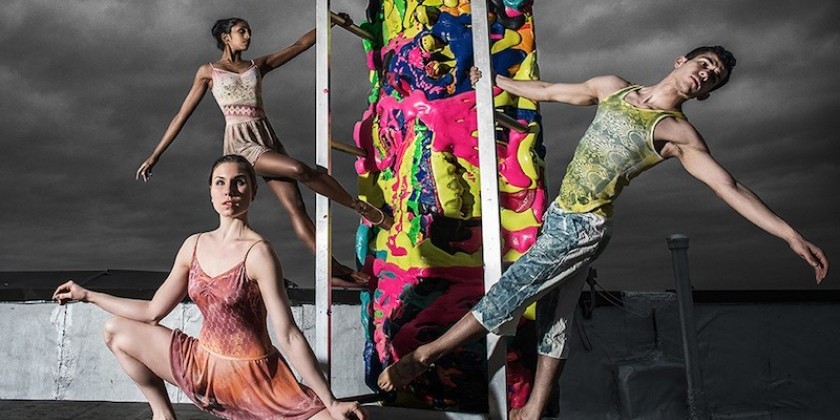THE DANCE ENTHUSIAST ASKS: Julia Gleich’s "CounterPointe" is Art in Motion

Female Choreographers and Visual Artists Come Together to Create Something Entirely New
ABOUT: For over a decade, CounterPointe has been redefining the relationship between dance and visual art, offering a rare platform where female choreographers and visual artists come together to create something entirely new. Co-founded by Julia Gleich (Gleich Dances), this annual series isn’t just about performance — it’s about collaboration, experimentation, and pushing artistic boundaries.
As CounterPointe gears up for its latest season (which is already almost sold out!) The Dance Enthusiast’s Theo Boguszewski sat down with Gleich to discuss the origins of the series, the challenges women face in the dance world, and creative risk-taking that keeps CounterPointe at the forefront of the art scene.
WHEN: Mar 7-9, 2025
WHERE: The Mark O'Donnell Theater, 160 Schermerhorn St, Brooklyn, NY
TICKETS: Click here
Theo Boguszewski for The Dance Enthusiast: I'm here to talk to you about CounterPointe. Let's go back to the beginning. What initially inspired you to create CounterPointe back in 2012? And how has the production evolved over the years?
Julia Gliech: Well, when I moved back to New York in 1995, I started working with Lynn Parkerson, the founding artistic director of Brooklyn Ballet. I think we met at the 92nd Street Y.
She was doing this thing called Dance at Holy Trinity, which was a Trinity Church on the Upper East Side. I began to work with her to produce these evenings of dance. And they were primarily women choreographers. She and I both agreed that what women really need is just the chance for their work to be seen. And then Dance Data Project came out, and we thought, well, yes, women need opportunities. Men get a lot of opportunities, and often you'll hear critics say, say, “We'd really like to see this young male choreographer continue to develop his work, because we think it's promising,” but you just really don't hear that about women. You win or you lose in that one piece that you make, and then it's kind of over. I mean, I'm exaggerating slightly.

So anyway, going off of the Virginia Woolf idea that a woman needs a room of her own and money to write fiction, we thought, “Let's create a program where we produce work by women.” Not to make women's work, but just to create a platform where women can make new work.
Norte Maar is very much involved in collaboration, and we really felt like there needed to be a stronger collaborative element. That's when we started pairing up the choreographers with visual artists to create a new work. It's not a festival. You don't bring a work that you've already made. There's no pay to enter. This is an entirely commissioned and produced evening of new dance collaborations.
Do you separately choose the visual artists and the dancers and then make the pairs?
Yeah, I do. The choreographers submit. It's a really simple process. They send me an email, cover letter, CV, some links, no fee, no form to fill out. And then I select the choreographers. Then I look at the visual artists who are interested.
For the visual artists, I go through recommendations and inquiries and occasionally we'll see somebody and we'll think, "Oh, that person might do a really great job in CounterPointe," and we'll just reach out to them — cold. This has really taken off in the visual arts world; they enjoy the process. They see their art differently, they learn a whole different environment.

The thing that we want to do is find the right artist and choreographer pair. We have no way of knowing. In most cases they've never met each other and we make our best stab at it. You know, we use a little intuition, sometimes based on what we know of their existing work.
What are some of the more interesting or memorable collaborations that you've seen over the years?
There are so many. Oh, a bunch that stand out. I mean, one of the luxuries of this is that I get to choreograph every year. Partly this is a vehicle for me to have to make work because it's a heavy lift to continue to make work.
Niki Lederer worked with these plastic Tide laundry detergent containers and she created super tall sculptures with those cut containers. They hung down on either side of the space and were lit, and it was just stunning. Really, really beautiful work. JoVonna Parks has done a couple of works, and one of them last year with Jeanne Verdoux. It was quirky and fun. It had a projection that the artist had taken JoVonna’s arms and face, and they were running across the screen. It was intriguing, unexpected, surreal.

Has the series always been at the Mark O'Donnell Theater?
It has. Everybody says, why don't you go into a bigger venue now that you sell out? Because we sell out every show now. But if you go to a bigger venue, you have a little less control over the installation of the materials. The Mark O'Donnell Theater, they know us, they trust us. We can go in, we can hang things, we move things around. We like to think of the space as adjacent to the idea of a gallery space. It's a black box. We don't get soft curtains hanging, so everything's exposed. And you watch us install the art for each piece. There's a whole art handling component where you see the things forming before you.
You mentioned that CounterPointe sells out every year. Why do you think that audiences are so drawn to this production?
You're going to see dance, and there are people who love dance, and they just like to see bodies moving in space or physicality. So you get some of that. If you like pretty ballet, there may be a little bit of that, too. I do keep the pointe shoe involved because I think that, especially for women, that is the hardest place, ironically, for them to get into the field.
But then there's this whole other side of it. First of all, it's like going to seven galleries in one evening because it’s got that much variety. You think about what the choreographer and the artist were doing together… what ideas were they developing. How are they working together. You spend time thinking about the art of it and not just the presentation and I find that really compelling because then people speculate. They see more in what's presented. Maybe they make stories. Maybe they only think about the materials and the relationship of a dancer to materials in space. And, even though it's not spoken outright, I really do believe audiences are conscious of that dialogue. We're trying to make it visible. We're not trying make it all slick and clean so that you don't have that experience.
Do you feel like there's been a shift in your audience demographics over the years?
It is a little hard to know. I think we started with dance audiences, but not exclusively. Norte Maar always draws in a visual arts audience. The artists specifically buy a lot of the tickets in December. I think they're really excited to see what visual art does in that dance environment. And I think that over the years the audience has become skewed more towards visual artists.

Your press release describes “CounterPointe as challenging how the pointe shoe can be used as a tool for contemporary expression.” Can you speak a little bit more about that?
Yeah. The pointe shoe. The point shoe is challenging, because it's laden with so many symbols. It’s like a tutu. A tutu, for me, is a piece of tulle, a piece of fabric. You don't earn the privilege to wear a tutu. You could buy one at a store. It can be special, but it's only special because of an artistic environment that you put it in. I'd like to think that we could take that approach with pointe work. We could say, it's a tool that we use to access different approaches to gravity and off centeredness. Maybe it extends the line.
We have this silly little moment in the piece that I'm making with Nicole Cherubini where the dancers have to sit on a little cube, and the cube is low. One dancer (Annie Freeman)is en pointe, and one dancer (Kara Chan) is not. They each place one foot behind the cube. Annie uses the pointe shoe as a lever to sort of perch or sit, that doesn't work as well for Kara. It's a detail. This can be done without a pointe shoe, but, boy, it's comfortable and easy in a pointe shoe.

I just wish the elevation of pointe work as some sort of pinnacle of glory could be made less distant and brought more into the art world. That's my fantasy, that we could work in that way where the dance is the dance and pointe shoes are part of it.
Can you speak a little bit about this upcoming show: any particular artists or collaborations that you're excited about?
We have a long-time Norte Maar artist Elisabeth Condon who is collaborating. She did a giant mural for us in Highland Park in Brooklyn. I'm eager to see what she makes. I'm working with Nicole Cherubini, who has a really big reputation as an installation visual artist and ceramicist. And that's exciting.
Margaret Wiss is working with Amy Talluto, and she's a repeat. I loved her work the first time around. It was quirky and weird and actually, the visual artist performed in it. It was great. And Amy Talluto does a podcast. She's really interesting, smart. There's also Deborah Lohse, who's collaborating with Micki Spiller. Deborah works with The Bang Group, and does a lot of comedy in her dancing work. She says she's doing a seven-minute "Swan Lake". I'll be curious. I haven't seen any of these works yet.
And one other thing you might find interesting. We pair these teams up in December, so they essentially have two months to make a work. That takes some of the risk away — those decisions that you think “ah that’s not a good decision, let me find another.” Well, you don’t have time for that. You lean into some of your early decisions and I think that that's a nice place to be sometimes.

Marazzi and Sassoon&Chizuco in CounterPointe 2022. Photo: JordanGartenberg
Do you have a sense of the different ways that the artists approach collaborating?
It runs the gamut. I want them to talk to each other. The whole point is that it should open up new avenues of thought. So no matter what happens, there should be the opportunity to talk to another artist, choreographer and have your ideas listened to, or challenged, or let them morph into a shared idea. Should you decide that collaboration means, “I'm going to go over here in this room to make my thing, and you're going to go over there,” like Cunningham and Cage, that's okay. But I really encourage them to have those first conversations. Some people are very hands on. Occasionally the visual artist appears in the work. In my piece this year we're going to have the art handlers appear in the work.
What is your personal choreographic approach to collaborations with different artists?
It’s hard to separate creating dance from the collaborative process because you're working with dancers who are people who have thoughts and points of view. I presented a paper recently called “If Paint Had Consciousness.” It was about this idea of the medium being able to think for itself and react to what's happening. I really like for the dancers to be present, to be human in work.
You know, you have this postmodern approach to movement where everything has equal value. Then you have the ballet world, where only some things have really high value. And then you have this other place in between. I live in that space. I'm not making narratives usually, but there is a narrative component always. This year we're working with Virginia Woolf text because if Wayne McGregor can choreograph Virginia Woolf and use a mostly male creative team to do that, I think we have permission to work with the Virginia Woolf text.
I'll tell you one other thing; I use a vector theory approach to dance, which is that dancing in space is directed energy in space. And any point on your body can be directed energy. And the laws of physics say that energy travels in a straight line, so you can't curve. Everything is about force and interrupted force or restrictions on that force. I think that really is tantamount to human intention. What do I do? I walk there to do something. I pick something up, I look over. It’s all about directing energy somewhere.

Women choreographers are still unrepresented in ballet and modern dance. Do you feel that this has changed in the last 10 years? How does CounterPointe think about shifting this narrative?
There may be more confidence and risk taking. I don't like to think of myself as an activist and I don't want CounterPointe to be a place where the political messages outweigh the creative process. I'm not sure that Counterpointe is really capable of shifting anything, but there's extreme value to me in being a place where women can make work and be creative and maybe feel a little less risk because the environment is not so competitive. And that sounds like I'm diminishing it, but I don't mean that. It’s just that not so produced, so tied up in a bow.
What advice would you give to an aspiring female choreographer who wanted to carve out her own creative space in this world?
It's a hard road. Ultimately you have to make work for you. Don't try to be famous. Just make the work you want to make. Do it often. Try to find a group of people who want to work with you. That will help keep you motivated because there is a feedback process.
Don't be afraid of making small works or making big works. Let your artistic vision guide you and really try to cut out the noise. There's a lot of noise. Look at the opportunities, get your applications out there, but just use your own voice and your own creative impulse.











